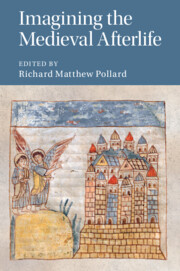Book contents
- Imagining the Medieval Afterlife
- Cambridge Studies in Medieval Literature
- Imagining the Medieval Afterlife
- Copyright page
- Contents
- Figures
- Contributors
- Preface and Acknowledgements
- Abbreviations
- Imagining the Medieval Afterlife: Introduction
- Part I Chronological Surveys
- Part II Theological Perspectives
- Part III Artistic Impressions
- Part IV Notable Authors and Texts
- Chapter 12 Visions and the Afterlife in Gregory’s Dialogues
- Chapter 13 The Vision of Tnugdal
- Chapter 14 The Afterlife in the Visionary Experiences of the Female Mystics
- Chapter 15 Dante’s Other-Worldly Surprises and This-Worldly Polemic
- Bibliography
- Index
- Cambridge Studies in Medieval Literature
Chapter 13 - The Vision of Tnugdal
from Part IV - Notable Authors and Texts
Published online by Cambridge University Press: 07 December 2020
- Imagining the Medieval Afterlife
- Cambridge Studies in Medieval Literature
- Imagining the Medieval Afterlife
- Copyright page
- Contents
- Figures
- Contributors
- Preface and Acknowledgements
- Abbreviations
- Imagining the Medieval Afterlife: Introduction
- Part I Chronological Surveys
- Part II Theological Perspectives
- Part III Artistic Impressions
- Part IV Notable Authors and Texts
- Chapter 12 Visions and the Afterlife in Gregory’s Dialogues
- Chapter 13 The Vision of Tnugdal
- Chapter 14 The Afterlife in the Visionary Experiences of the Female Mystics
- Chapter 15 Dante’s Other-Worldly Surprises and This-Worldly Polemic
- Bibliography
- Index
- Cambridge Studies in Medieval Literature
Summary
The Vision of Tnugdal (1149) was written in Latin in Regensburg. It provides a case study for the genre of otherworld visions. The author, an Irish monk, shows the influence of Bernard of Clairvaux, in his treatment of divine mercy and justice as expounded by a guide who accompanies the visionary and explains the nature of the otherworld. Hell is segmented into eight locations for different punishments. The less grievous sinners, still redeemable, are at the top, with those eternally damned already in the pit of hell. Outside a segmented heaven two intermediate locations are designated for those neither particularly good nor particularly bad. This lengthy and popular work demonstrates considerable learning and a unique creativity with its vivid descriptions of punishments and demons and its spatial, intellectual, and spiritual vision of heaven. The vision expounds a theology of fear while extoling the redemptive power of both internal and external pilgrimage.
Keywords
- Type
- Chapter
- Information
- Imagining the Medieval Afterlife , pp. 247 - 263Publisher: Cambridge University PressPrint publication year: 2020

